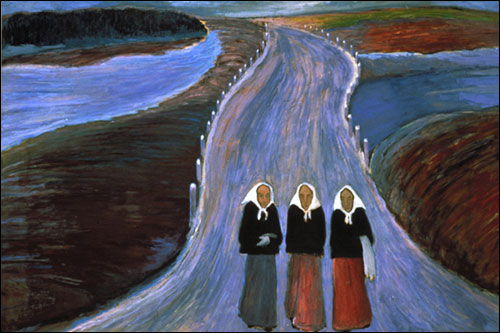Switzerland Russia
dal 16/2/2006 al 20/5/2006
Segnalato da
16/2/2006
Switzerland Russia
Musee d'Histoire, Lausanne
Centuries of love and neglect. 1680-2006

Centuries of love and neglect. 1680-2006
Curated by Alexandra Kaourova and Laurent Golay
An exceptional ensemble of 200 works, objects and documents reveals the wealth of the history of the exchanges between the two countries, from the end of the 17th century to our day.
To celebrate the one hundredth anniversary of the establishing of diplomatic relations between Russia and Switzerland, the Muse'e d'Histoire has gathered an exceptional ensemble of over 200 works, objects and documents, on loan from nearly 30 institutions and a great number of private collectors in Switzerland and in Russia. Paintings, drawings, prints, jewels, photographs, models, diaries, documents from archives, from Faberge' to Auberjonois, including Nabokov, Jawlensky, Werefkin, Patek Philippe or Leonhard Euler, reveal the extraordinary wealth of the history of exchanges between the two countries, from the end of the 17th century to our day. A history in which the actors were architects, private tutors, jewelers, wine growers, musicians, strategist, photographers, students, revolutionaries, painters or clockmakers. The exhibition is organized in two phases, before and after 1917, and in two parts, the Swiss in Russia - the Russians in Switzerland. A short film, based on documents from archives never seen before by the public, underlines the strong moments of the presence of the Russian revolutionaries, students and anarchists in Switzerland, around the years1900, and a few crucial moments in the relations between the two countries.
The Swiss in Russia
From Peter the Great to the last Romanov, the Swiss played an eminent role in regard to the Russian monarchs. Architects from the Tessin region went to Russia at the beginning of the XVIIIth century. Russia offered them the huge material and human resources needed to carry out large projects. Generations of builders from the Tessin region succeeded one another. Swiss scientists played a major role in scientific research in Russia. Under the reign of Peter the Great various scientists from Basel took part in the creation, and then the expansion, of the Acade'mie des Sciences Kunstkamera in Saint Petersburg... Clockmakers, jewellers, enamellists, miniaturists - in particular from Geneva - who felt limited in Switzerland, went to seek their fortune on the banks of the Neva, where their know-how was greatly appreciated by the Russian empresses for whom they created sumptuous jewellery. But the Swiss emigrants to Russia did not all rub elbows with the Tsars… They were also governesses, hotel employees in Saint Petersburg, or wine growers in the wine-growing region of Chabag. Following the tensions of the Cold War, cultural exchanges picked up again. Swiss and Russian artists developed interest in the other’s patrimony. Good examples of this new creative spirit are Juri Shtapakov, the creator of an edition of ’Histoire de Soldat (The History of the Soldier), or stage director Pierre-Alain Bertola who made the settings for Voyage a' Reims (Trip to Reims), by Rossini, at the Mariinsky Theatre.
The Russians in Switzerland
The Russians discovered Switzerland very early. Its idealized landscapes entered the Russian imagination through the works of Albert de Haller, Jean-Jacques Rousseau and above all Nicolai Karamzine. In 1799, general Suvorov chased Napoleon’s army across the Alps during an epic expedition. The Russian troops left traces in the topography of certain areas, in particular in Zurich, and in the Russian historiography. During the 19th century and the beginning of the 20th, Switzerland was home for a small part of Russia. A. Herzen, P. Kropotkin, M. Bakunin, Vladimir Oulianoff (Lenin) spent periods there, as did a great number of students. Among them there were many women committed to the social cause. Switzerland granted them political asylum, while keeping a close watch on them. The revolutionary ideas led to demonstrations and debates. At the eve of WW I, Switzerland appeared as an oasis to a great number of Russian artists. Diaghilev settled in Lausanne with the Ballets Russes. He kept company with Ansermet, Cingria, Stravinsky and Ramuz - who composed the Histoire du soldat, with settings by Rene' Auberjonois. At the same time, Alexej von Jawlensky and Marianne von Werefkin revolutionized landscape representation. As for Vladimir Nabokov, he chose Switzerland for its calm and... its butterflies. It was at the Montreux-Palace that he wrote his famous novels Ada, Regarde, regarde, les arlequins! Transparent things, Speak memory.
PUBLICATION
Catalogue of the exhibition, Texts by Peter Collmer, Me'lanie Draveny, Galina Glushanok, Eric Hoesli, Olga Kirikova, Nicolai Kopanev, Tatiana Moiseeva, Mario Redaelli, Alain Rochat, and Pia Todorovic. 96 pages, 48 illustrations, in French or in Russian, Benteli publications, CHF 39. - + postage
Image: MARIANNE WEREFKIN die Landstrasse, 1907, tempera (c) Fondation Marianne Werefkin, Museo comunale d’arte moderna, Ascona
PRESS CONTACT: Marie Perny Te'l. +41 21 315 41 01 E-mail : marie.perny@lausanne.ch
MUSE'E HISTORIQUE DE LAUSANNE: 4, place de la Cathe'drale 1005 LAUSANNE
OPENING HOURS: Tuesday to thursday 11h am-6pm. Friday to sunday 11am -5 pm Closed monday except Easter and Whit Monday.
PRICES OF ADMISSION: Full rate: CHF 8 Concessions: CHF 5



